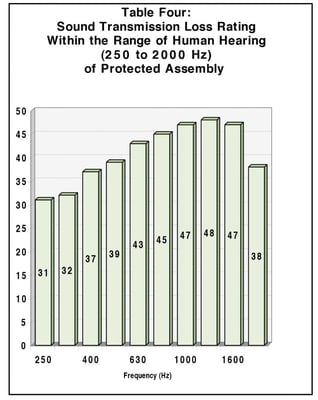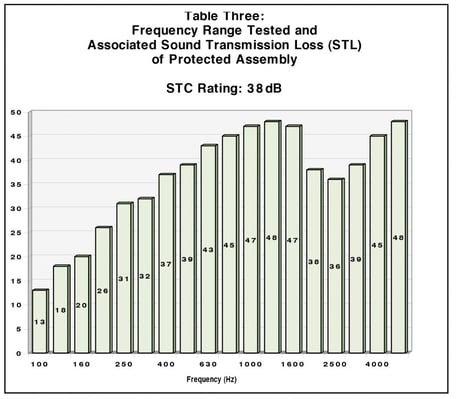STI quiets the competition
The importance of maintaining the intended ratings of walls is paramount in the design and construction of buildings. Fire and 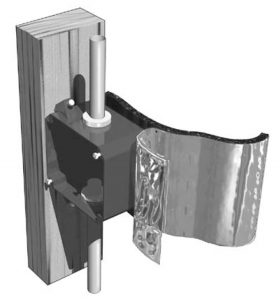 acoustical transmission ratings severely affect the safety and comfort afforded by all types of dwellings found worldwide. Construction techniques and materials utilized must ensure that both fire and acoustical sound are limited in their propulsion throughout a structure, which they are, in a sense, contained. Compartmentalization of both the transmission of acoustical sound and fire can easily be achieved by selecting proper materials and construction techniques. Specified Technologies, Inc. has devoted years of research to the development of the world’s most advanced fire stopping products and systems. This research has spawned the incorporation of our products into the acoustical sound containment arena. The use of our products will not only assure the safety afforded by the containment of life threatening fire but will also ensure greater comfort levels achieved by limiting and/or eliminating the transmission of acoustical sound.
acoustical transmission ratings severely affect the safety and comfort afforded by all types of dwellings found worldwide. Construction techniques and materials utilized must ensure that both fire and acoustical sound are limited in their propulsion throughout a structure, which they are, in a sense, contained. Compartmentalization of both the transmission of acoustical sound and fire can easily be achieved by selecting proper materials and construction techniques. Specified Technologies, Inc. has devoted years of research to the development of the world’s most advanced fire stopping products and systems. This research has spawned the incorporation of our products into the acoustical sound containment arena. The use of our products will not only assure the safety afforded by the containment of life threatening fire but will also ensure greater comfort levels achieved by limiting and/or eliminating the transmission of acoustical sound.
Acoustical sound transmission testing incorporates a similar stringent testing regimen as that associated with firestopping products. American Society of Testing and Materials (ASTM) provides several testing procedures for this purpose. Of these, designations E90 and E413 are viewed as baseline standards. ASTM designations E90 entitled Standard Test Method for Laboratory Measurement of Airborne Sound Transmission Loss of Building Partitions and Elements and E413 entitled Classification for Rating Sound Insulation illustrate the procedures for measuring sound transmission loss through partitions and calculating the overall rating. These standards analyze the entire system (i.e. the partition, including all joints, gaps, etc.) to determine the Sound Transmission Loss (STL) and Sound Transmission Classification (STC) rating.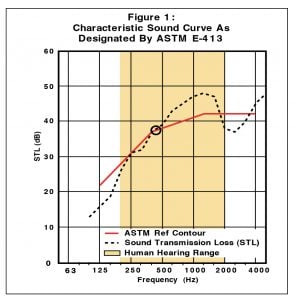
Sound Transmission Loss (STL) is the degree to which the sound level is reduced due to sound isolation characteristics of a partition. Measured in decibels (dB), the greater the sound reduction the greater the STL rating. Calculation of the STL is based on the Sound Transmission Coefficient (t), which is defined as the fraction of incident sound transmitted through it. As such, Sound Transmission Loss is defined as:
STL = 10 log (1/t)
Where: STL = Sound Transmission Loss
t = Sound Transmission Coefficient
The overall performance of an assembly is rated by the Sound Transmission Coefficient (STC). This rating incorporates the above criterion applied across 16 one-third-octave bands within the frequency range of 100 and 5000 Hz. Results generated within the range of 125-4000 Hz are fitted to a characteristic sound curve as designated by ASTM E413 (see Figure One) from which an STC rating is generated. The test method described by ASTM E90 incorporates two rooms that are divided by a separating partition. The specimen to be examined (in our case is a typical gypsum wallboard assembly) is installed within the separating 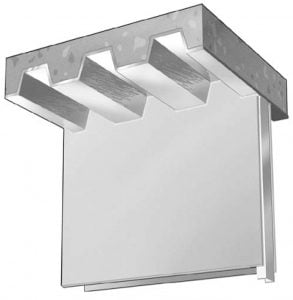 partition as indicated by Figure Two. The rooms, one called the source room and the other the receiving room, are constructed using techniques that ensure sound transmission occurs only through the test specimen. The source emits sounds, in each of 16 one-third-octave bands ranging from 100 to 5000 Hz, that travel through the test partition and is detected by the receiver. Reverberation is also analyzed and noted within the source room. In this way, sound decay is measured and by determining STL ratings and the STC rating is
partition as indicated by Figure Two. The rooms, one called the source room and the other the receiving room, are constructed using techniques that ensure sound transmission occurs only through the test specimen. The source emits sounds, in each of 16 one-third-octave bands ranging from 100 to 5000 Hz, that travel through the test partition and is detected by the receiver. Reverberation is also analyzed and noted within the source room. In this way, sound decay is measured and by determining STL ratings and the STC rating is 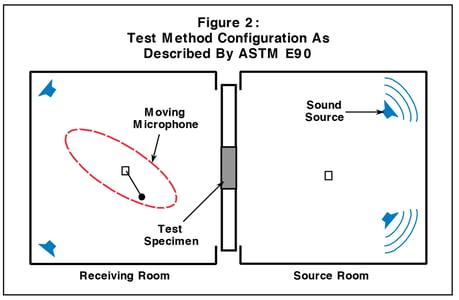 calculated by procedures outlined by E413. Specified Technologies, Inc. has conducted sound attenuation testing with a typical gypsum wallboard assembly in accordance to ASTM E90 and E413. STL and STC ratings were investigated with installation of common accessories (electrical boxes, etc.). Assemblies were tested with and without the installation of fire stopping/sound attenuating sealant. Initial tests of these partitions were conducted with all joints sealed with duct tape as to simulate tape and finished joints (as per E90); electrical outlet boxes were installed but remained unprotected. Table One indicates the frequency range tested and associated sound transmission loss (STL) ratings associated with the assembly. From this we can determine the STC rating of the entire wall assembly to be 37 dB, noting the STL ratings between the frequencies of 250 and 2000 Hz. (average range of human hearing) range between 30 and 45 dB (see Table Two). The same wall assembly was then tested with all joints and electrical boxes protected with SpecSeal® Series ES Elastomeric Sealant (Cat. No. ES100) and SpecSeal® Putty Pads (Cat. No. SSP4S), respectively (as per ASTM C919). Table Three depicts the results achieved with the installation of these products.
calculated by procedures outlined by E413. Specified Technologies, Inc. has conducted sound attenuation testing with a typical gypsum wallboard assembly in accordance to ASTM E90 and E413. STL and STC ratings were investigated with installation of common accessories (electrical boxes, etc.). Assemblies were tested with and without the installation of fire stopping/sound attenuating sealant. Initial tests of these partitions were conducted with all joints sealed with duct tape as to simulate tape and finished joints (as per E90); electrical outlet boxes were installed but remained unprotected. Table One indicates the frequency range tested and associated sound transmission loss (STL) ratings associated with the assembly. From this we can determine the STC rating of the entire wall assembly to be 37 dB, noting the STL ratings between the frequencies of 250 and 2000 Hz. (average range of human hearing) range between 30 and 45 dB (see Table Two). The same wall assembly was then tested with all joints and electrical boxes protected with SpecSeal® Series ES Elastomeric Sealant (Cat. No. ES100) and SpecSeal® Putty Pads (Cat. No. SSP4S), respectively (as per ASTM C919). Table Three depicts the results achieved with the installation of these products.
It was discovered that by protecting all joints and penetrations with SpecSeal® products the overall STC rating of the assembly was increased to 38. More important are the STL ratings within the average range of human hearing (250 to 2000 Hz.). Remember the
STL rating is a measure of how the sound level is reduced for the specific frequency tested. Table Four indicates that the overall STL rating was increased by two decibels between 315 Hz and 500 Hz, four decibels between 630 Hz and 800 Hz, five decibels at 1000 Hz, three decibels at 1250 Hz, 2 decibels at 1600 Hz, and 1 decibels at 2000 Hz.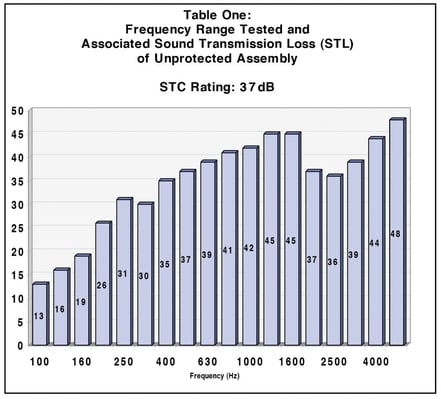

These increases in STL rating mean a significant decrease in the level of sound transmitted through partitions and significantly increase the comfort levels within the dwelling.
As these results indicate, the installation of SpecSeal® Firestop products can greatly increase both the safety and comfort levels within a structure. As already noted, the spread of fire through a structure can be greatly reduced and/or eliminated by utilizing various SpecSeal® products installed as indicated by our many Underwriters Laboratories, Inc. classified systems (most in the industry). Beyond these advantages are the sound attenuation properties of our materials, specifically SpecSeal® Series ES Elastomeric Sealant
(Cat. No. ES100), and SpecSeal® Putty Pads (Cat. No. SSP4S). It has been determined that installation of these products increase both the Sound Transmission Classification and Sound Transmission Loss of tested assemblies. As such, these products have been tested to the requirements of ASTM E90, and can be certified as meeting the specification of ASTM C919.
